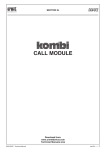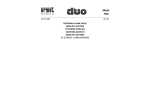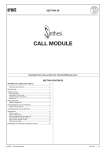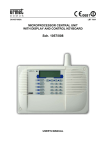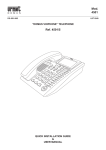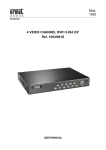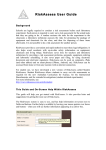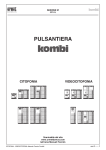Download 1556 KB
Transcript
SECTION 2A (REV.F) CALL MODULE Download from: www.urmetdomus.com Technical Manuals area. SECTION CONTENTS CAPABILITIES .................................................................................2 Description of the terminals ..........................................................2 TECHNICAL DATA...........................................................................3 FUNCTIONING.................................................................................3 Call for name selection .................................................................3 Code for call composition .............................................................3 Direct calls ....................................................................................3 Additional codes and functions .....................................................3 Programming of decoding boxes ..................................................4 PROGRAMMING..............................................................................4 Programming methods .................................................................4 Parameters ...................................................................................4 Programming using the Ref. 1038/56 Terminal ............................5 Local programming via keyboard..................................................6 TROUBLESHOOTING AND REPLACEMENT...............................12 Display ........................................................................................12 Electric lock ................................................................................12 Replacement procedure .............................................................12 ADDITIONAL ALPHABETIC KEYPAD Ref. 1038/74 .....................13 Technical data ............................................................................13 INSTALLATION ..............................................................................13 Flush mounted version ...............................................................13 ACCESSORY INSTALLATION ......................................................15 Flush mounted version with wall cover frame.............................15 Flush mounted version with rain hood ........................................15 Wall mounted version with case and hood .................................15 Gate semi-flushed panel accessories.........................................16 Examples of modular constructions............................................17 ENTRY OF THE LOCK RELEASE CODES .....................................7 Methods of insertion .....................................................................7 Insertion using the 1038/56 terminal ............................................7 Entry via keyboard ........................................................................8 Complete erasure .........................................................................8 NAME MANAGEMENT ....................................................................8 Management methods ..................................................................8 Management using personal computer and Ref. 1038/56 terminal ...................................................................8 Management using the Ref. 1038/56 terminal..............................9 Management via keyboard .........................................................10 Complete erasure .......................................................................10 SOUND LEVEL ADJUSTMENT .....................................................11 DISPLAY CONTRAST ADJUSTMENT ..........................................11 ERROR CODES.............................................................................11 Errors during normal operation ...................................................11 Errors during installation/programming.......................................11 Self test.......................................................................................12 DIGIVOICE - Technical Manual sec.2a −−−− 1 Ref. 1038/13 SINTHESI CALL MODULE WITH DIRECTORY Ref. 1038/13 CAPABILITIES - DESCRIPTION OF THE TERMINALS SINTHESI CALL MODULE WITH DIRECTORY SINTHESI CALL MODULE WITH DIRECTORY Ref. 1038/13 1 2 3 8 4 9 +V 0V D FA FB FA2 FB2 +F 0F MS 5 MP2 +V 0V D FA1 FB1 MP1 Sch./Ref. 1038/13 S/N ...................... Data:.................... 10 CONTR. 11 1 4 2 5 3 6 6 7 7 8 9 SE- +V SE+ SC 0V SL T2 S12 T1 0V SP S1 H S2 P 12 0V PH MA X The Ref. 1038/13 Call Module is based on Sinthesi mechanics with 2 modules. Although it is not equipped with the embedding box and related module-holder frame (which can be bought separately), it is complete with anti-theft screw for security of installation. CAPABILITIES SINTHESI CALL MODULE The Call Module comprises: The Ref. 1038/13 Call Module with repertory provides the following capabilities: • Possibility of forwarding a house phone or video house phone call (in combination with the Ref. 1745/70 TV camera unit). • Automatic management of house phone and video house phone traffic according to the number of voice lines available (1 or 2). • Selection, using scroll keys and a 2-line, 16-character back-lit alphanumeric display of the name to be called. Up to 740 separate names are available. • Direct selection, via keyboard, of an alphanumeric call code (in combination with the Ref. 1038/74 Additional Alphabetic keyboard). This means that up to 159999 separate call codes are available. • Possibility of managing up to 2 direct call keys (in combination with the Ref. 1145/11 or 1145/12 module) for calls to specific users or to a main entrance switchboard. • Up to 980 lock release codes divided into two categories: 240 codes independent of the names, for general use, plus another 740 codes associated to the individual names. • Up to 7999 codes for special services. • Impulse type lock release (free or with secrecy) with maintenance current for timed driving (from 1 to 30 seconds) of a low absorption electric lock. • Acoustic and visible signaling of driving of the electric lock. • Programmable call tone duration from 1 to 5 seconds. • Differentiated generation of the call tone, continuous tone in the case of main module, intermittent tone if a secondary module. • ‘Call forwarded’ and ‘end of conversation’ acoustic signals. • Adjustment of service and acoustic signal intensity. • Interface for door open sensor. • Possibility of programming the names using the Ref. 1038/56 programming Terminal; direct access to programming (for minor modifications) from the external keyboard without having to use the terminal. • Auto-insertion function without the need for dedicated wiring. • Provision for operation in 11 languages: Italian, French, English, German, Spanish, Hebrew, Russian, Dutch, Turkish, Portuguese, Polish. 2 −−−− sec.2a MV 0 1 2 Two-module Sinthesi front. Connector for programming using the Ref. 1038/56 Programming Terminal. 3 Adjustable call module speaker volume. 4 Programming button (for use only when password is not known). 5 Alphanumeric display, two-rows, 16-characters, back-lit. 6 Yellow back-lit name selection buttons. 7 Green back-lit number pad buttons with yellow back-lit function buttons: “Cancel” ‘X’, “Key” ‘ ’ and “Call” ‘ ’. 8 Additional alphanumeric keyboard (1038/74) connector. 9 Extractable terminal strips for system connections (MP1, MP2, MS). 10 Label with indication of the serial number (S/N) of the device. 11 Adjustable LCD contrast. 12 Extractable terminal strips for local auxiliary services (MA) and video signal (MV). DESCRIPTION OF THE TERMINALS MP1 – Main terminal strip +V 0V D FA1 FB1 Power supply positive (+24V) Power supply and data line ground Data line Voice circuit 1 to conductor Voice circuit 1 return conductor MP2 – Main terminal strip FA2 FB2 +F 0F Voice circuit 2 to conductor Voice circuit 2 return conductor Voice circuit power supply positive (+33V) Voice circuit ground MS – Secondary terminal strip +V 0V D FA FB Power supply positive (+24V) Power supply and data line ground. Data line Voice circuit to conductor Voice circuit return conductor DIGIVOICE - Technical Manual Ref. 1038/13 TECHNICAL DATA -FUNCTIONING MA – Auxiliary terminal strip PLEASE SPEAK Electric lock driving output - negative Electric lock driving output - positive Keys/contacts/buttons common Input Key 2 for dedicated call Input Key 1 for dedicated call Door sensor input Lock release code inhibition contact input Postman key contact input Main entrance locking button input During the conversation, any lock release command will be highlighted both audibly (3 beeps) and visibly with the following caption for 3 seconds: DOOR OPEN MV – Video terminal strip +V SC SL S12 0V S1 S2 0V At the end of the conversation, (or if no reply is received after approx. 30 seconds), the name selection message is redisplayed automatically accompanied by 3 beeps. Ref. 1038/68 video relay box power supply Ref. 1038/68 video relay drive output - riser Ref. 1038/68 video relay drive output - local Ref. 1038/68 video relay drive output - channels 1 and 2 Ref. 1038/68 video relay box ground Ref. 1032/9 video relay drive output for channel 1 Ref. 1032/9 video relay drive output for channel 2 Ref. 1032/9 relay devices ground CODE FOR CALL COMPOSITION The code entered on the keyboard of the Call Module (and optionally of the Ref. 1038/74 Additional Alphabetic Keyboard) is shown on the display. Pressing of each key is echoed by an audible signal: TECHNICAL DATA Power take-off in unitary loads: Logic circuits Logic p.s. voltage (+V/0V) : Maximum current draw: Voice circuits Voice circuit p.s. voltage (+F/0F): Operating temperature: CALL TO: 23 15LU 15 ÷ 25.2Vdc 400mA 30 ÷ 36Vdc -10 ÷ +50°C FUNCTIONING When the ‘ ’ key is pressed, the call is forwarded to the extension with the code entered. The buzzer of the indoor set called is activated for the time programmed (from 1 to 5 seconds) with a continuous tone (Main Call Module) or intermittent tone (Secondary Call Module). Three beeps confirm that the call has been forwarded. Subsequent pressing of the ‘ ’ key extends the buzzer activation time. When the ‘X’ cancellation key is pressed (in the case of an error during entry of the code), the number on the display is cleared. During the call, any lock release command will be indicated both audibly (3 beeps) and visibly with the following caption for 3 seconds: DOOR OPEN CALL FOR NAME SELECTION In normal functioning, the repertory displays the message inviting the user to select the name to be called: Select NAME with ↑ or ↓ Using the two scroll keys (6) it is possible to select the name to be called. At this point, simply press the ‘ ’ key to send a call to the name selected. The following message is displayed: CALL MADE NOTE: if the user simply presses the ‘ ’ key when invited to select the name, a call will be forwarded to the main entrance switchboard. Three confirmation beeps are emitted to indicate forwarding of the call. The buzzer of the indoor set called is activated for the time programmed (from 1 to 5 seconds) with a continuous tone (Main Call Module) or intermittent tone (Secondary Call Module). The name selected is then redisplayed and remains visible for approximately 30 seconds during which the buzzer of the indoor set can be activated again simply pressing the ‘ ’ key again. When the indoor set replies, the following prompt is displayed: DIGIVOICE - Technical Manual At the end of the conversation, (or if no reply is received after approx. 30 seconds), the name selection message is redisplayed automatically accompanied by 3 beeps. DIRECT CALLS Two particular users can be called pressing the matching keys of the Ref. 1145/12 Module if present. Any Ref. 1038/40 Main Entrance Switchboard can be called simply pressing the ‘ ’ key (without entering any code and without selecting a name) or alternatively one of the two Ref. 1145/12 Module keys (if present and suitably programmed). ADDITIONAL CODES AND FUNCTIONS The Call Module with Repertory is able to manage three separate groups of codes: • Call codes (1-JJJJ) Identify the house phone or video house phone indoor set called; during entry, codes consisting of less than four digits/letters must NEVER be preceded by zeroes (for example, enter “12A” and not “012A”). The call codes must always be terminated pressing the ‘ ’ key which activates forwarding of the code. • Lock release codes (numeric ONLY:1-99999999) Permit direct opening of the door by residents or by authorized persons; these codes must always be preceded and followed by pressing of the ‘ ’ key. Initial pressing of the ‘ ’ key prevents sec.2a −−−− 3 SINTHESI CALL MODULE SESE+ 0V T2 T1 SP H P PH SINTHESI CALL MODULE WITH DIRECTORY SINTHESI CALL MODULE WITH DIRECTORY Ref. 1038/13 Ref. 1038/13 SINTHESI CALL MODULE WITH DIRECTORY Ref. 1038/13 PROGRAMMING SINTHESI CALL MODULE WITH DIRECTORY display of the lock release code in which the digits are replaced with asterisks: LOCK RELEASE CODE ******** The lock release codes can be inhibited in pre-established time bands using an external timed switch that operates on the ‘H’ and ‘0V’ terminals. • Special codes (1-JJJ) Can be used to activate/deactivate auxiliary services such as the stair lights, garden lights etc. Must always be preceded by a ‘0’ (which prevents display of the codes) and followed by pressing of the ‘ ’ key: SPECIAL CODE: 0*** These codes also make it possible to check the status of an input showing this on the display with the ‘On’ or ‘OFF’ caption; for example: TERMINAL STATUS: ON For further information refer to the Ref. 1038/80 Special Decoding box User Manual. NOTE: in the case of an error during entry of any code, press the ‘X’ cancel key: the code shown on the display will be cleared. PROGRAMMING OF DECODING BOXES The Ref. 1038/13 Call Module with Repertory can be used by the installation technician to program the decoding devices. For a description of the parameters and programming methods, refer to the decoding boxes User Manual. In any case, if a parameter is programmed successfully, the display of the module will show: Programming OK Otherwise, the following message is displayed: SINTHESI CALL MODULE Programming KO PROGRAMMING PROGRAMMING METHODS The Call Module with Repertory can be programmed in three different ways (in any case only when powered): 1) Programming using the Ref. 1038/56 Programming Terminal. This programming method is recommended as the display of the terminal facilitates the operations involved. The terminal may be connected: • Locally on the programming connector (2) to the Call Module to be programmed. • On any other Call Module or Main Entrance Switchboard included in the system. • On any Passive Plug (Ref. 1038/90) connected in the system. 4 −−−− sec.2a 2) Locally via keyboard without having to open the frame of the Module. In this case, the configuration access password must be known. 3) Locally via keyboard opening first of all the frame of the Call Module to press the rear programming button (4). PARAMETERS The following parameters must be programmed: A) The operating language One of the listed languages can be selected in more consecutive screen forms. B) Description of the installation site This is a 15-character string that must be used to assign the Call Module a mnemonic name: e.g. ‘Entrance V. Roma’, ‘Corso Venezia’, ‘Stair A’, ‘Stair B’. In actual fact, it is possible to insert up to 30 characters but, in the fast search phase, only the first 15 will be shown. It is advisable therefore to restrict the name to 15 characters and to use the remaining characters for any additional information. C) 11 parameters to be configured 1) Type of Call station It is possible to select between a Main Call station from which calls can be made to all indoor sets or to the main entrance switchboard and a Secondary call station from which calls can be made only to the indoor sets of the specific riser. 2) Call station code Each call station, whether Main or Secondary, is identified by a code. The codes that can be assigned to a call station depend however on whether this is Main or Secondary. • If Main, the code will be between ‘1’ and ‘JJJ’; • If Secondary, the code will be between ‘1’ and ‘JJ’ and will indicate the riser to which it belongs. 3) Busy time The busy time defines the minimum duration of a call (including the time that passes between forwarding of the call and reply by the user). To guarantee this minimum duration, the system may – in the case of several concurrent calls - set one or more call stations to ‘Busy’ status which is shown on the display with the following message: LINES BUSY Please wait When a Call Module has been set to Busy status, it cannot be used to send calls (although it can be used to enter lock release codes). The busy time may be 10, 20, 30 or 40 seconds. 4) Electric lock management Opening of the electric lock from an indoor set may be ‘Free’ (FREE) or ‘With Secrecy’ (‘SEC’): In the first case, the door can be opened at any time; in the second case, it can be opened only during the conversation. The criteria according to which the various electric locks are managed is important for correct functioning of the system. ALWAYS COMPLY SCRUPULOUSLY WITH THE INSTRUCTIONS GIVEN BELOW BECAUSE ONLY THE CONFIGURATIONS DESCRIBED ARE PERMITTED. • In installations with a single main call station and no secondary call station, the call station can be configured either with FREE LOCK RELEASE OR LOCK RELEASE WITH SECRECY. • In systems with several main call stations (in automatic switching), all the call modules must be programmed with LOCK RELEASE WITH SECRECY. DIGIVOICE - Technical Manual Ref. 1038/13 SINTHESI CALL MODULE WITH DIRECTORY Ref. 1038/13 PROGRAMMING 6) Duration of call ring Indicates the duration of the call ring on the indoor set. It is advisable to program the same value on all call stations. Permissible values (in seconds) range from 1 to 5. 7) Number of voice lines The number of voice lines (including Main and Secondary) in the system must be specified. Settable values are ‘1’ and ‘2’. 8) Buzzer Sound Level The intensity of the acoustic signals (key pressed, call forwarded, end of conversation beeps, etc.) can be adjusted to 3 possible levels: Minimum (Min), Medium (Med), Maximum (Max). 9) Code associated to Key T1 In the case of combination with a Ref. 1145/11 or -/12 module, the code associated to pressing of the first key must be specified. If this key is to send a call to a specific Main Entrance Switchboard - both during the day and night but not when off – program the indoor set code of the Main Entrance Switchboard. If the key is to send a call to any switchboard present that is in ‘day A’ condition, program ‘0000’. Programmable codes are between ‘0000’ and ‘JJJJ’. 10) Code associated to Key T2 This is the code associated to the second key of any Ref. 1145/12 module. Programmable codes range from ‘0000’ to ‘JJJJ’. 11) Saving of the Configuration Access Password and (automatically) of the lock release code programming password. The password must be numeric ONLY and must consists of 4 digits. The password programmed in this way can then be used to access module configuration without having to open the Sinthesi frame. Programming of the configuration access password automatically enables a second password that can be used to program name and lock release codes. This second password is derived from the first with an increment of 1. If, for example, ‘1234’ has been programmed, the name and lock release code programming password will be ‘1235’. The installation technician can therefore reveal to others (system administrator, porter etc.) ONLY the name and lock release code programming password avoiding any risk of access also to configuration parameters. The values that can be programmed range from 0001 to 9998. DIGIVOICE - Technical Manual USING THE Ref. 1038/56 Programming using the terminal must be carried out with the system on. • Switch on the terminal holding down the ‘ON’ key for at least 3 seconds. • Insert the programming cable in the specific outlet (2) or alternatively – on another call Module, Main Entrance Switchboard or Passive Plug. The terminal will be connected automatically to the data line and the following message will be shown on the display for 3 seconds: Programming and then: Find: <Serial Number> <Type> <Acquisition> SINTHESI CALL MODULE WITH DIRECTORY 5) Door open time Indicates the time (in seconds) of duration of the electric lock maintenance current. WARNING: when locks that do not require latching current are used, ALWAYS set the lock release time to zero. In the case of low absorption locks ONLY, the door open time can be set between 1 and 30 seconds. PROGRAMMING TERMINAL • Select the <Serial Number> option. The following message is displayed: Serial number: 000000 Enter the serial number of the Call Module (given on the rear label (10) at the S/N item), and press ↵ key. The following message is displayed: REP SN: uvwxyz --------------Road . . . . . . . . . . . . . At this point, the terminal is connected logically with the Call Module with Repertory (REP) with the selected serial number (‘uvwxyz’). To indicate that the module is in Maintenance status, the display of the module will show: MAINTENANCE Please wait NOTE: the module permits management of the electric lock also in ‘Maintenance’ status, both following entry of a lock release code and activation of the main entrance button or of the postman key contact. • At this point, the following can be programmed: the description of the installation site, the 11 configuration parameters and the operating language divided into four pages: sec.2a −−−− 5 SINTHESI CALL MODULE • In systems with at least one secondary call station, the main call station(s) must be programmed with LOCK RELEASE WITH SECRECY. The secondary call station(s) can be programmed as required with FREE LOCK RELEASE OR LOCK RELEASE WITH SECRECY. In the first case, after a call from the main station, activation of the lock release key on the indoor set called will cause opening of the lock connected to the main call station and of the lock connected to the secondary station on which that indoor set depends. In the second case, following a call from the main station, activation of the lock release key on the indoor set called will cause opening of the lock connected to the main calling station only; a second call must then be made from the secondary station in order to open the lock connected to this. Ref. 1038/13 SINTHESI CALL MODULE WITH DIRECTORY Ref. 1038/13 PROGRAMMING (Page 1: Device recognized (REP) and its Serial Number, both nonmodifiable; Description of the installation site) LOCAL PROGRAMMING VIA KEYBOARD SINTHESI CALL MODULE WITH DIRECTORY It is possible to access programming in 2 ways: REP SN:uvwxyz --------------Road . . . . . . . . . . . . . INCORRECT PASSWORD (Page 2: Type, Code, Busy, Lock Management) Type: P Cod:001 ---------------Busy: 10 s Lock Rel.: S-00 s (Page 3: Call time, number of lines, Buzzer level) Call:03 s Lines: 1 Buzzer: 2 (Page 4: T1 and T2 key code assignment and Password) Key 1:0000 Key2: 2:0000 Password: 9998 Language: English • Program all the parameters using the alphanumeric keys, the ← and → keys to move, the ↵ key to confirm, the ‘sp’ key to switch between the pre-established options. • Press the → (or ←) key several times to move to the following page <Names> <Lock release> <Program> <Cancel><Exit> SINTHESI CALL MODULE a) If the configuration access password is known (the password is factory set to ‘9998 ‘), enter ‘00’ followed by the 4-digit password and the ‘ ’ key. If the password is incorrect, the following message is displayed: • Position the cursor on ‘Program’ and press ↵. The terminal writes the data set in the memory of the Module and displays the result of the write operation. • Move to the page with the <Exit> option, position the cursor on this and press ↵. At this point (and ONLY at this point), the Call Module will exit Maintenance status and return to normal operation. • Disconnect the programming cable and switch off the terminal pressing the ‘OFF’ key for at least 3 seconds or if other call modules connected to the system are to be programmed, repeat the steps described above. After the third unsuccessful attempt, entry of the password is blocked for a period of time that depends on the number of unsuccessful attempts: N. unsuccesfull Wait time before attempts new password insertion 1 2 3 4 5 6 . . 255 1 minute 2 minutes 3 minutes . . 252 minutes (above 4 hours) b) If the password is not known, open the Sinthesi frame and press the programming button (4). After inserting the correct password - or after pressing the programming button (4) – the following message is displayed for a few seconds: v1.0B 23/03/99 N.S.uvwxyz The first indication refers to the SOFTWARE version (in this case 1.0) and to the maximum number of programmable lock release codes: 240 (letter ‘B’ is displayed). These are followed by the date of the version and the serial number of the device (S/N) (‘uvwxyz’) coinciding with the serial number indicated on the rear label (this information makes it possible to check the serial number WITHOUT opening the Sinthesi frame). The main menu is then displayed: <LANGUAGE><CONFIG> <ID><TEST><ESC> a) Using the arrow keys, move the cursor to <LANGUAGE> and press the ‘ ’ key to access the screen form used to select operating language. The first screen form is as follows: <ITA> <FRA> <ENG> <DEU> <ESP> < > Move the cursor to language selected and press the ‘ Note: terminal Ref. 1038/56 can be set up only for English, Italian, French, Spanish and German. ’ key. b) To program the installation site description move the cursor to <ID> and press the ‘ ’ key The following is displayed: <Esc><Del><End>A 6 −−−− sec.2a DIGIVOICE - Technical Manual Ref. 1038/13 SINTHESI CALL MODULE WITH DIRECTORY Ref. 1038/13 ENTRY OF THE LOCK RELEASE CODES Once entry has been completed, position the cursor in the reduced <Esc><Del><End> menu. To do this, hold down the ↓ key until the cursor is positioned on the ‘E’ of <Esc>. To confirm insertion of the name, select the <End> item using the ↑ key and press the ‘ ’ key. c) Moving the cursor to <CONFIG> and pressing the ‘ ’ key, programming of the 11 configuration parameters distributed in subsequent screen pages is accessed. MODE TYPE: <MAIN> <SECOND> MODULE:CODE JJJ JJJ BUSY TIME:10s <10><20><30><40> keyboard is used). To correct any errors and restore the all data saved press the ‘X’ key. Once programming has been completed the main menu is redisplayed: <LANGUAGE><CONFIG> <ID><TEST><ESC> To restore normal functioning, select <ESC> and confirm with the ‘ ’ key. NOTE: to interrupt programming at any time and return directly to normal functioning simply press the ‘X’ key for more than 3 seconds. In this case the data entered so far will remain however valid. ENTRY OF THE LOCK RELEASE CODES The Call Module makes it possible to insert up to 240 lock release codes that are completely independent of the names, for general use. These codes must be numeric only and each consist of a number of digits that can be selected as required (between 1 and 8). Therefore the permitted range is 1 to 99999999. SINTHESI CALL MODULE WITH DIRECTORY Use the ↑ and ↓ keys to scroll the characters that can be entered. Press the ‘ ’ key to enter the character selected in the upper line of the display. Although up to 30 characters can be entered (starting from the time the 16th character is entered, the top line scrolls progressively to the left), it is advisable to restrict insertion to 15 because only 15 will be displayed in the search from Terminal. METHODS OF INSERTION DOOR OPEN T. 0s <-> <+> <OK> CALL T.:3s <1><2><3><4><5> VOICE LINES:1 <1> <2> BUZZER MED.LEV <MIN><MED><MAX> KEY 1:0000 0000 KEY 2:0000 0000 PASSWORD: 9998 9998 In all the screen pages, the programming method is identical: • Using the arrows, move the cursor to the option selected and then press the ‘ ’ key to confirm and move to the next screen page. • In screen pages in which a code must be inserted, use the numeric keys (and alphabetic keys if the Ref. 1038/74 additional alphabetic DIGIVOICE - Technical Manual The lock release codes can be inserted: 1) Using the Ref. 1038/56 Programming Terminal connected locally or at any other point of the installation. 2) Locally from keyboard. In this case, the password for programming of the names and lock release codes must be known (this is DIFFERENT from the configuration access password). INSERTION USING THE 1038/56 TERMINAL After establishing a logical connection with the call Module concerned (see description in ‘PROGRAMMING WITH THE 1038/56 TERMINAL), move to the following page: <Names> <Lock release> <Program> <Cancel><Exit> • Select <Lock release> and press ↵. The first 3 lock release codes will be displayed: Lockrel001:00000000 Lockrel002:00000000 Lockrel003:00000000 <P><S><OK><ESC> • Enter the code(s) required and then, using the ← and → keys move to the <OK> command and press ↵. WARNING: THE 3 CODES ARE EFFECTIVELY SAVED IN THE CALL MODULE ONLY FOLLOWING CONFIRMATION WITH THE <OK> COMMAND. Saving is confirmed visibly. • To access the three subsequent codes select the <S> command and press ↵. Alternatively, to access the three previous codes select <P> and press ↵ . sec.2a −−−− 7 SINTHESI CALL MODULE LOCK RELEASE TYPES: <FREE> <SEC> Ref. 1038/13 SINTHESI CALL MODULE WITH DIRECTORY SINTHESI CALL MODULE WITH DIRECTORY Ref. 1038/13 NAME MANAGEMENT • Once the codes have been programmed, select <EXIT> and press ↵ and then the ← key to move to the previous page, select <Exit> and press ↵. • Disconnect the programming cable and switch off the terminal pressing the ‘OFF’ key for at least 3 seconds or if the same lock release codes have to be programmed on another call module connected in the system repeat the steps described above. NOTE: to delete a lock release code, reprogram this to ‘00000000’. ENTRY VIA KEYBOARD • Enter ‘00’ followed by the 4-digit password (for programming of the names and lock release codes) and by the ‘ ’ key. If the password is incorrect, the following message is displayed: INCORRECT PASSWORD After the third unsuccessful attempt, entry of the password is blocked for a period of time that depends on the number of unsuccessful attempts: No. unsuccessful attempts Wait time before new password insertion 1 2 3 4 5 6 1 minute 2 minutes 3 minutes • • • • 255 252 minutes (above 4 hours) Once the password has been entered correctly the display will show: <Names> <Lock release><Esc> • Select <Lock release> and press ‘ ’. The first page with the first two lock release codes will be displayed: Lockrel001:00000000 Lockrel002:00000000 SINTHESI CALL MODULE • Enter the lock release code and then confirm with the ‘ ’ key. • Use the Arrows to check the codes already inserted and to move to the new codes. • To exit the code entry phase and return to normal functioning press the ‘X’ key for at least 3 seconds. NOTE 1: instead of scrolling all the codes with the Arrow keys, it is possible to find the first free space holding down the ‘ ’ key for at least 3 seconds. NOTE 2: to delete a lock release code, reprogram this to ‘00000000’. <LANGUAGE><CONFIG> <ID><TEST><ESC> • On the keyboard press the ‘ display will show: ’ key and ‘5’ at the same time. The Erase ALL? <Y> <N> • Answering ‘YES’, all the Lock Release Codes and all the Names (see below) stored in the device will be deleted. Answering ‘No’, another two prompts will be displayed for confirmation of ONLY the Names or ONLY the Lock Release Codes: Erase names? <Y> <N> Erase lock release? <Y> <N> • Answering ‘No’ to the first prompt and ‘Yes to the second, ONLY the Lock release Codes will be deleted. NAME MANAGEMENT It is possible to enter up to 740 names. Each name includes the following information: • Name of the user (maximum 32 alphanumeric characters distributed on two 16-character lines). • User code, alphanumeric (between ‘1’ and ‘JJJJ’). • Lock release code, numeric only (between ‘1’ and ‘99999999’). It is possible to proceed in such a way that several names (different from each other) correspond to the same call (in the case of several people living in the same apartment). If the call code is to be displayed beside the name, simply save the call code also in the 32 characters dedicated to user name. MANAGEMENT METHODS Names can be managed: 1) Using a Personal Computer and the Ref. 1038/56 Programming terminal. 2) Using the Ref. 1038/56 Programming Terminal, connected locally or at any other point of the installation, mainly for modifications, cancellations and short entries 3) Locally, from keyboard, mainly for modifications, cancellations and short entries. In this case, the password for programming of the names and lock release codes must be known (this is DIFFERENT from the configuration access password). MANAGEMENT USING PERSONAL COMPUTER AND 1038/56 TERMINAL COMPLETE ERASURE In some cases, it may be useful to delete all the lock release codes inserted (for example to reinstall the same device in another building). Complete erasure of the lock release codes is possible only using the keyboard: • Enter ‘00’ followed by the 4-digit password for access to the configuration (NOT that for lock release code management). The main menu is displayed: 8 −−−− sec.2a The best way to manage the names is to use the DVOICE Personal Computer programs specifically designed to simplify insertion and maintenance of the names of one or more sites. The DVOICE program can be downloaded free of charge from the Urmet Domus Internet site (http://www.urmetdomus.com). The installation technician (or building administrator) may therefore proceed: DIGIVOICE - Technical Manual Ref. 1038/13 SINTHESI CALL MODULE WITH DIRECTORY Ref. 1038/13 NAME MANAGEMENT The various operations are described in detail below. SAVING OF THE DATABASE ON THE PC Using the DVOICE program, create a new site on your PC and save the names of the residents together with any other relative information (such as for example the lock release codes). For further information, refer to the DVOICE program. TRANSFER OF THE DATABASE FROM PC TO THE 1038/56 TERMINAL • Connect the programming Terminal to the selected serial port of the PC using the specific cable provided. • set the DVOICE program to download the Database of the site on the Terminal. • Switch on the terminal. The following message is displayed: To program connect cable <Configur.> <Database> <PC> • Select <PC> and press ↵. The following message is displayed: <PC-TP> <TP-PC> <Exit> • Select the <PC-TP> item, press ↵ and answer YES to the subsequent confirmation prompt: transfer of the Database from PC to Terminal will start. • On completion of transfer, return to the main page, switch off the terminal and disconnect the cable from the PC. CHECKING AND MODIFICATION OF THE DATABASE Once the names Database has been loaded on the terminal, it can be examined and modified. To do this, access the <Database> item from the main page and then select one of the possible options: <Display> <Insert> <Modify> <Cancel><Exit> • Select <Names> and press ↵. The name Management menu is displayed: <Insert> <Modify> <Cancel><Exit> <REP-TP><TP-REP> • Select <TP-REP>, press ↵ and answer YES to the subsequent confirmation prompt: transfer of the Database from the Terminal to the Module selected is started. • Once transfer has been completed disconnect the cable and switch off the terminal pressing the ‘OFF’ key for at least 3 seconds, or if the same database is to be programmed on another call module in the system repeat the steps described above. NOTE: in the case of a database with many names, transfer may take a number of minutes. A horizontal square bar will indicate state of completion. TRANSFER OF A NAMES DATABASE FROM ONE CALL MODULE TO ANOTHER (OR TO A PC) To ‘copy’ the names from one call Module to another, use the Terminal. Establish a logical connection with the first Module (that from which the names are to be copied) and select first of all <Names> and then <REP-TP>: the names database will be copied on the terminal. At this point, it can be downloaded on another call module or, changing the cable of the Terminal, on PC. SINTHESI CALL MODULE WITH DIRECTORY • To save the names of a site on his own PC. • Transfer the database of names from the PC to the 1038/56 Programming Terminal. • Inject the database of names in one or more Call Modules of the site (connecting the terminal at any point of the site). MANAGEMENT USING THE 1038/56 TERMINAL After establishing a logical connection with the Call Module concerned (see description in PROGRAMMING WITH THE 1038/56’ TERMINAL), move to the page: <Names> <Lock release> <Program> <Cancel><Exit> Select <Names> and press ↵. The name Management menu is displayed: <Insert> <Modify> <Cancel><Exit> <REP-TP><TP-REP> TRANSFER OF THE DATABASE FROM THE 1038/56 TERMINAL TO ONE OR MORE 1038/13 CALL MODULES • After establishing the logical connection with the Call Module concerned (see description in the ‘PROGRAMMING USING THE 1038/56 TERMINAL paragraph’), go to the following page: <Names> <Lock release> <Program> <Cancel><Exit> DIGIVOICE - Technical Manual _ Code:0000 Lock rel.:00000000 Enter the Name, on a maximum of 2 lines of 16 characters each for a total of 32 characters and press ↵. Enter the call code (between ‘1’ and ‘JJJJ’) and the lock release code associated to the name (numeric only, between 1 and 99999999). When the specific prompt is displayed, confirm. sec.2a −−−− 9 SINTHESI CALL MODULE INSERTION OF A NAME Select <Insert>. The following message is displayed: Ref. 1038/13 SINTHESI CALL MODULE WITH DIRECTORY Ref. 1038/13 NAME MANAGEMENT SINTHESI CALL MODULE WITH DIRECTORY Continue in this way inserting all the names. At this point, press the <Esc> key to return to the Name Management menu. CANCEL/MODIFY A NAME Selecting <Cancel> or <Modify> from the name Management menu, the following prompt is displayed: Select the name with the ← and → keys Scroll the names until that to be deleted/modified is shown. WARNING: during scrolling, only the first 16 characters of each name are displayed. When the name concerned has been found, stop without pressing any key; after approx. 3 seconds, the remaining 16 characters of the name and the other parameters associated with these will be displayed. To delete, press ↵ and confirm. To modify, make the changes required then press ↵ and confirm. NOTE: when a name is deleted, any associated lock release code is automatically deleted together with the name. MANAGEMENT VIA KEYBOARD This type of programming can be used as an alternative method to that described above only for minor operations such as for example insertion, modification or deletion of a single name. Enter ‘00’ followed by the 4-digit password (for programming of the names and lock release code) and by the ‘ ’ key. If the password is incorrect, an error message will be output (for further details see the paragraph on insertion of lock release codes using the keyboard). Once the correct password has been inserted, the display will show: <Names> <Lock release><Esc> Select <Names> and press ‘ ’. The Name Management menu will be displayed from which to access all the functions: <ADD> <CAN> <MODIFY> <ESC> INSERTION OF A NAME Selecting <ADD>, the following is displayed: SINTHESI CALL MODULE <Esc><Del><End>A Use the ↑ and ↓ keys to scroll the characters that can be entered. Press the ‘ ’ key to enter the character selected in the upper line of the display; starting from the 16th character of the name, the upper line will be gradually shifted to the left, It is possible to insert up to 32 characters. Once entry has been completed, position the cursor in the reduced <Esc><Del><End> menu. To do this, hold down the ↓ key until the cursor is positioned on the ‘E’ of <Esc>. To confirm insertion of the name, select the <End> item using the ↑ key and press the ‘ ’ key. Continue as described above to insert the call code (between ‘1’ and ‘JJJJ’) and the lock release code associated to the name (numeric only, between 1 and 99999999): 10 −−−− sec.2a Code: <Esc><Del><End>0 Lock rel:00000000 <Esc><Del><End>0 Any errors during entry can be corrected selecting the <Del> item, which deletes the last character inserted. Use <Esc> to abandon the operation without saving the data entered. NOTE 1: if the name inserted is already present in the memory, an error message is output. NOTE 2: if the code inserted is present in the memory, a confirmation is requested: Code present Confirm? <Y><N> CANCEL/MODIFY A NAME Selecting <DEL> or <MODIFY> from the name Management menu, the following is displayed: FIND NAME WITH ↑ OR ↓ Using the ↑ or ↓ keys, scroll the names present until that to be deleted or modified is reached. Press the ‘ ’ key and delete the name (after confirmation) or modify this (proceeding as described above for insertion). NOTE 1: if a name is deleted, any associated lock release code is automatically deleted together with the name. COMPLETE ERASURE In some cases, it may be useful to delete all the lock release codes inserted (for example to reinstall the same device in another building). Complete erasure of the lock release codes is possible only using the keyboard. From Terminal • After establishing a logical connection with the call Module concerned (see description in ‘PROGRAMMING WITH THE 1038/56 TERMINAL), move to the following page: <Names> <Lock release> <Program> <Cancel><Exit> • Select <Names> and press ↵. The name Management menu is displayed: <Insert> <Modify> <Cancel><Exit> <REP-TP><TP-REP> DIGIVOICE - Technical Manual Ref. 1038/13 SINTHESI CALL MODULE WITH DIRECTORY Ref. 1038/13 SOUND LEVEL ADJUSTMENT - DISPLAY CONTRAST ADJUSTMENT - ERROR CODES Cancel entire repertory? <No> <Yes> where ‘entire’ means however deletion of the Names ONLY (and not of Lock release Codes). Selecting ‘YES’ and confirming with the ↵ key all the Names will be deleted. From keyboard • Enter ‘00’ followed by the 4-digit password for configuration access (NOT the name management password). The main menu is displayed: <LANGUAGE><CONFIG> <ID><TEST><ESC> • On the keyboard, press the ‘ display will show: ’ and ‘5’ keys at the same time. The Erase ALL? <Y> <N> • Answering ‘YES’, all the Names and all the Lock Release Codes stored in the device will be deleted. Answering ‘No’, another two prompts will be displayed for confirmation of ONLY the Names or ONLY the Lock Release Codes: Erase names? <Y> <N> Erase lock rel? <S> <N>Y ERROR CODES Various types of error codes are put on the display. ERRORS DURING NORMAL OPERATION Call to a non-existent user: ERROR NON EXISTENT Call from a secondary call module to a user of another riser: RISER ERROR At least one key is jammed: KEYBOARD JAMMED Door lock release code incorrect or disabled: SINTHESI CALL MODULE WITH DIRECTORY • Press ← key for 3 seconds. The following prompt is displayed: LOCK REL. NON-EXIST ERRORS DURING INSTALLATION/PROGRAMMING No signal on data line (terminal ‘D’ not connected or signal missing): DATA LINE ERROR Insertion of an incorrect Password: • Answering ‘YES’ to the first prompt, ONLY the Names will be deleted. SOUND LEVEL ADJUSTMENT The sound level towards the indoor set called is factory set and does not require adjustment. The sound level towards the outside is factory set to a medium value. To modify this, use a screwdriver on adjustment (3). PASSWORD INCORRECT Attempt to insert a name already present in the memory: ERROR NAME PRESENT DISPLAY CONTRAST ADJUSTMENT Display contrast is factory set to an optimal level. It can however be modified using a screwdriver on the related adjustment (11). ERROR MEMORY FULL Attempt to modify or delete a name with the memory empty: ERROR MEMORY EMPTY DIGIVOICE - Technical Manual sec.2a −−−− 11 SINTHESI CALL MODULE Attempt to insert a name with the memory full: Ref. 1038/13 SINTHESI CALL MODULE WITH DIRECTORY Ref. 1038/13 TROUBLESHOOTING AND REPLACEMENT SELF TEST ERROR EPROM MISSING ERROR EEPROM Name memory fault: 1 Configuration memory fault: 19 70 W 0 E 2. M V. SINTHESI CALL MODULE WITH DIRECTORY Configuration memory not present: circuit paying particular attention to the direction of insertion (notch on the body of the component and on the socket); replace integrated circuit MEW 7019, taking care to orient it correctly on installation. • Re-place the rear cover. • Power on the new Call Module. WARNING: after replacing the memory, the serial number of the new call Module automatically becomes that of the old Module: remember to modify the indications on the rear label (10) by hand. U3 ERROR FLASH TROUBLESHOOTING AND REPLACEMENT DISPLAY In the case of problems with the display, check first of all that contrast is correctly set, using the rear adjustment (11). A further check can also be carried out accessing – by entering the configuration password or pressing the rear key – the main menu: <LANG.><CONFIG> <ID><TEST><ESC> Select <TEST> and press the ‘ displayed: ’ key. Check that the control figure is At this point, the matching character is displayed for each key pressed. Press the ‘ ’ key, to return to the previous menu and then select <ESC> to restore normal functioning. SINTHESI CALL MODULE ELECTRIC LOCK In the case in which the electric lock fails to open, the cause can be quickly traced: • If the module emits a beep and the electric lock does not open, the fault is in the section from the module to the electric lock or in the module drive circuitry. • If the module not only fails to open the electric lock but does not even emit a beep, this means that the lock release command is not received from the module: the fault is located on the indoor set side. REPLACEMENT PROCEDURE In the case of a fault in the module, replace the entire module. If many lock release codes have been programmed, it is possible to remove the integrated circuit on which the codes are stored and to re-insert this in the new module. The name memory can be replaced in the same way. • Cut off the power to the old Ref. 1038/13 Call Module. • Remove the rear cover applying a light pressure on the side hooks. • Remove the U3 and MEW 7019 integrated circuit. • Remove the rear cover of the new module; replace the U3 integrated 12 −−−− sec.2a DIGIVOICE - Technical Manual Ref. 1038/13 SINTHESI CALL MODULE WITH DIRECTORY Ref. 1038/13 ADDITIONAL ALPHABETIC KEYBOARD Ref. 1038/74 - INSTALLATION ALPHABETIC KEYBOARD INSTALLATION WARNING: for wiring and the maximum permissible distances, follow the instructions given in the section 1 of this manual. A B C D E F G H I X J The Call Module must be installed on Sinthesi frame (not provided). The anti-theft screw provided must be used instead of the normal screw furnished with the Sinthesi frame in order to guarantee installation security. Calling module with repertory Ref. 1038/13 can be used alone or in combination with a camera unit and/or alphabet keyboard add-on Ref. 1038/74. Examples of modular constructions using 2 or 3 module holder frames with respective flush-mounting boxes are shown below The door unit module should be installed at a height of approximately 1.55 ÷ 1.60 metres. The Ref 1038/74 Additional Alphabetic Keyboard makes it possible to introduce letters of the alphabet in the call code and special code composition phase. The device must be combined with a Ref. 1038/13 Call Module to which it is connected using the specific connection cable. In any case, the device must be positioned BELOW (or at the most to the SIDE) of the Ref. 1038/13 Call Module). 1 2 3 4 5 6 7 8 9 X 0 h = 1,55 ÷ 1,60 m TECHNICAL DATA Power take-off in unitary loads: Logic circuits Power supply voltage: Power take-off when idle: Operating temperature: 3LU 15 ÷ 25.2Vdc ~27mA -10 ÷ +50°C SINTHESI CALL MODULE WITH DIRECTORY ADDITIONAL Ref. 1038/74 Important The module should not be illuminated from behind to make the calling module display easier to read. Never direct the module towards strong sources of light (e.g. the sun, lampposts, light bulbs, flashes or glare). FLUSH-MOUNTED VERSION • Fit the flush mounting box in line with the wall: it must not project. • Fit the module holder frame. SINTHESI CALL MODULE A 4 mm DIGIVOICE - Technical Manual sec.2a −−−− 13 Ref. 1038/13 SINTHESI CALL MODULE WITH DIRECTORY Ref. 1038/13 INSTALLATION Purchase flush-mounting boxes, frames and module holders separately for wall mounting. The product codes (according to number of modules) are: NUMBER OF MODULES 2 3 4 FLUSH-MOUNTING BOX 1145/52 1145/53 1145/54 FRAMES AND MODULE HOLDERS 1145/62 1145/63 1145/64 Refer to “Technical product manual - Door phone and video door phone systems”, “Sinthesi panels” section for dimensions and additional details on these products. • Turn the frame round and connect wires. J2 SINTHESI CALL MODULE WITH DIRECTORY • Fit the module in the frame. 2 GT 3 GT 4 GT 0~ ~ 12 J2 2 GT 3 GT 4 GT 0~ ~ 12 • Adjust correct perpendicularity of the panel. Close the frame and fasten the screw A. Position the panel on the frame. Fasten screw B on screw A. A SINTHESI CALL MODULE B A A B 14 −−−− sec.2a B A DIGIVOICE - Technical Manual Ref. 1038/13 ACCESSORY INSTALLATION ACCESSORY INSTALLATION WALL-MOUNTED VERSION WITH CASE AND HOOD FLUSH-MOUNTED VERSION WITH WALL COVER FRAME The case and hood is provided with frame and module holder. The available models and the dimensions are shown in “Technical product manual - door phone and video door phone systems” section “Sinthesi Panels”. Fasten the hood to the wall by means of three bolts. Arrange the hole for passing the wires through the lower area of the casing and the head. The wall cover frames are used to conceal possible irregularity of the wall surrounding the flush-mounting box. The available models and the dimensions are shown in “Technical product manual - door phone and video door phone systems” section “Sinthesi Panel”. Embed the flush mounting box in the wall, position the wall cover frame and fasten the module holder lower screw. Frame fastening is completed by tightening the upper frame screw last. Fit the modules in the frame then position the panel. A SINTHESI CALL MODULE WITH DIRECTORY SINTHESI CALL MODULE WITH DIRECTORY Ref. 1038/13 4 mm FLUSH-MOUNTED VERSION WITH RAIN HOOD Rain hoods are used to protect the calling module from the weather. The available models and the dimensions are shown in “Technical product manual - door phone and video door phone systems” section “Sinthesi Panels”. Embed the flush mounting box in the wall, position the waterproof hood and fasten the module holder lower head. Hood fastening is completed by tightening the upper frame screw last. A SINTHESI CALL MODULE A A 4 mm DIGIVOICE - Technical Manual sec.2a −−−− 15 Ref. 1038/13 SINTHESI CALL MODULE WITH DIRECTORY SINTHESI CALL MODULE WITH DIRECTORY Ref. 1038/13 ACCESSORY INSTALLATION GATE SEMI-FLUSHED PANEL ACCESSORIES Fit the modules on the frame. Cases and hood for gate pillar installation are suitable for vertical installation on a gate pillar. The available models and dimensions are shown in “Technical product manual door phone and video door phone systems” section “Sinthesi Panels”. Drill a hole dimensioned as shown on the provided template in the pillar and arrange the case on the pillar. WARNING: Eliminate a crossbar with cutters to fit double modules. To fasten the case: a Push the screw to the bottom of the box with a screwdriver. b Push the screw outwards with a screwdriver. c Fasten the screw. A C SINTHESI CALL MODULE B 16 −−−− sec.2a DIGIVOICE - Technical Manual Ref. 1038/13 SINTHESI CALL MODULE WITH DIRECTORY Ref. 1038/13 ACCESSORY INSTALLATION EXAMPLES OF MODULAR CONSTRUCTIONS 2 modules 3 modules SINTHESI CALL MODULE WITH DIRECTORY Reccommended calling module constructions are shown below. 4 modules Ref. 1745/70 (∗) 1,55 - 1,60 m Ref. 1038/13 1 2 3 4 5 6 7 8 9 X 0 Ref. 1038/13 1 2 3 4 5 6 7 8 9 X 0 A B C Ref. 1038/13 D E F G H I X J Ref. 1145/52 Ref. 1038/74 1 2 3 4 5 6 7 8 9 X 0 A B C D E F G H I X J Ref. 1145/53 Ref. 1038/74 Ref. 1145/54 Sch./Ref. 1038/13 S/N ...................... Data:.................... CONTR. Ref. 1038/13 Ref. 1038/74 Ref. 1038/74 Sch./Ref. 1038/13 S/N ...................... Data:.................... CONTR. Ref. 1038/13 Sch./Ref. 1038/13 S/N ...................... Data:.................... Ref. 1038/13 Ref. 1745/70 (∗) (∗) A colour camera Ref. 1745/40 can be fitted as an alternative. DIGIVOICE - Technical Manual sec.2a −−−− 17 SINTHESI CALL MODULE CONTR. 18 −−−− sec.2a DIGIVOICE - Technical Manual


















